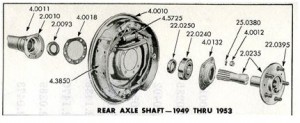The first thing to do is check the gear oil level in the differential. Lack of oil can cause a noise in the differential gears. It should be within a ½ inch of the upper hole and should be 80/90 weight oil. If oil is low, check your pinion seal as well as the large, round gasket where the differential meets the axle housing and the outside of your rear brake backing plates for leaks. If your pinion seal is leaking, unless you have the necessary tools and equipment it is best replaced by a professional, as the bearing and pinion nut need to be specially dealt with. The shop manual has details. The large gasket, sold by Olson’s Gaskets, can be replaced without special equipment by removing the differential, though be careful as it is very heavy.
If there is a leak on the rear brake backing plates, (4.0010 in the diagram below.) ascertain whether it’s brake fluid or gear oil. If gear oil, there are oil seals on the outer ends of the axles (2.0093 in the diagram.), which when faulty will permit leaks of gear oil into the wheel area which will then drain out a hole where the axle meets the outside of the backing plate. To replace the seal, you must remove the axle, pull out the seal with a seal removing tool (or pry it out with the end of the axle) and drive the new seal all the way in with a large socket wrench or similar tool. (I can lend members my home-made tool if need be.) When you re-install the axle, spread some chassis grease on the rubber part of the seal so the axle doesn’t scrape and damage it. Such a leak can also be caused by a faulty gasket between the backing plate and the axle housing (4.0018). To replace this gasket, remove the axle, unscrew the hydraulic brake line from the wheel cylinder and remove the backing plate.
Check the axle bearings by driving the car when the noise is present. One way to tell if an axle bearing is causing the noise is to turn the car sharply in one direction and then the other. If the noise varies in intensity while doing this, it could signify a bad bearing. To replace an axle bearing (22.0240), you must remove the axle. It is not essential to remove and replace the seal at the same time, but it would be prudent to do so. The bearing must be pressed on the axle by a machine shop, being careful not to score the surface on the end of the axle that the seal rides on. (Now that cars are mostly front wheel drive, there are fewer auto machine shops that press on rear axle bearings.) These bearings and seals are sold by Olcar Bearings, Southern Pines NC for a reasonable cost, though you may find them at a modern auto parts supplier as they are standard for many cars. .
If you eliminate an axle bearing as the cause of the noise, the remaining possibility, of course, is that the noise is in the differential assembly. Assuming you’ve fixed any leak, if the noise is just a hum the differential can go for years without failing or causing any further problems, other than being annoying. (My own has been making such a noise for 20 years.) If you feel you must fix a noisy ’49 Cadillac differential, besides replacing the pinion bearing the shop manual recommends you not try to work on it and, in any case, does not tell you how to do so. Apparently, the problem is that some of the internal parts are held together by special pins that can only be removed by destroying them and some other parts nearby. The only possible fix is to replace it. Prez Joe Cutler has several ’49 parts cars and can probably sell you a good (quiet) used one.
